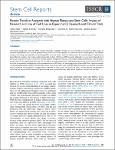Recent Trends in Research with Human Pluripotent Stem Cells: Impact of Research and Use of Cell Lines in Experimental Research and Clinical Trials
Guhr, Anke
Kobold, Sabine
Seltmann, Stefanie
Seiler Wulczyn, Andrea E. M.
Kurtz, Andreas
Löser, Peter
The human pluripotent stem cell (hPSC) research landscape is rapidly evolving. To assess possible novel trends in hPSC usage, we analyzed experimental hPSC research published from 2014 to 2016 and compared our data with those of earlier periods. The number of papers describing experimental work involving hPSCs increased further with clear differences in the scientific impact of publications from different countries. Our results confirm the leading position of US-based hPSC research, although to a lesser degree than observed previously. Our data reveal that research into human induced pluripotent stem cells alone surpassed human embryonic stem cell (hESC) research by 2015 and rapidly grew after that. We also report on continuing and even slightly growing research activities in the hESC field as well as on a generally declining rate of the generation of new hESC lines. An increasing portion of new hESC lines represents disease-specific and clinical-grade cell lines. The previously noted usage of only a few early established hESC lines in the vast majority of scientific work is sustained. We also provide a comprehensive overview on clinical trials on the basis of hPSCs. We find that the vast majority of those trials are based on hESC-derived cell products that were generated from an only limited number of relatively old cell lines.
Dateien zu dieser Publikation

